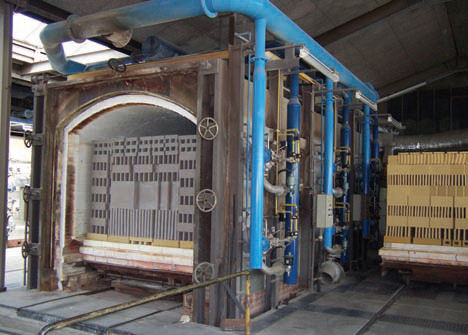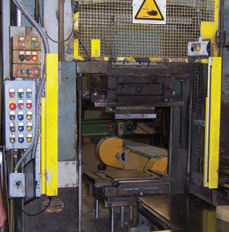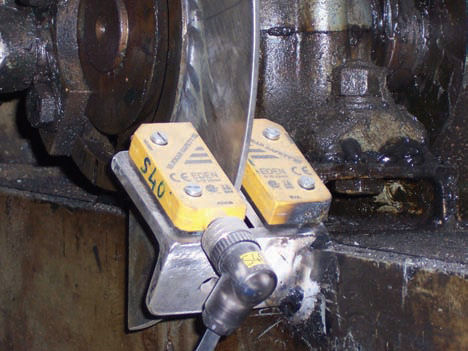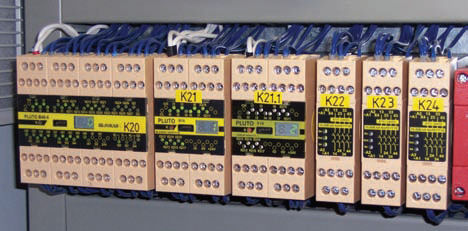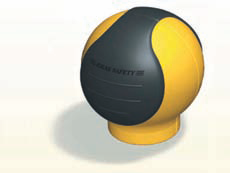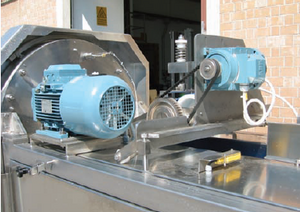For the production of the fire-resistant moulded tiles, first compounded clay is prepared which, depending on the desired final product, consists of different ingredients such as chamotte, clay and white earth from the local region. The shaping is performed by extrusion moulding, pressing or stamping by hand. The shaped moulded blanks are placed on drying hurdles and either carried to the drying ovens or to the drying plant. Then the moulded tiles are stacked on hearth shuttles and pushed into the pottery kiln, where the products are fired at 1000 to 1400°C. After a temperature holding time of up to 12 hours, the firing procedure is finished. Now follows an approx. 36 hours long cooling-down phase, where programme-controlled fans are blowing cool outside air into the firing kiln. In order to save energy, the hereby generated waste heat is used in the drying plant. The finished moulded tiles are finally discharged, palletised and commissioned. The operating processes in the presses are decisive for the quality and dimensional accuracy of the moulded tiles and are based on decades of experience. One of the crank presses is used to compress the moulded blanks and press out the residual air. Already here, the observance of the narrow tolerance of the end measures requires taking into account the shrinkage which occurs during drying and firing. A high productivity is achieved by using a multiple press which can be operated from two sides and enables either continuous or singlestroke operation. The presses, which will shortly undergo the CE type examination, are fully equipped with safety components and all of them meet the requirements for the highest safety category 4. Since the presses are also operated by subcontracted workers, the protection of persons was designed to be particularly safe. The safety control of all equipment is performed by the Pluto B46-6 safety PLC's with 46 inputs and outputs in total, some of which are connected to BT51 expansion relays for increasing the number of output contacts. Since the programming is via the intuitive Pluto Manager software in the ladder diagram, Pluto can be used both for safety monitoring and for controlling smaller machines. The only 22.5mm wide safety relays BT51T are intended for the connection of safety components, such as emergency switches. They offer 4 NO safety outputs, test input with complete internal supervising, and hardwired selectable delay times from 0 to 1.5 seconds. For monitoring the position of hatches, covers and machine parts, dedicated electronic safety sensors Eden with a dynamic output signal are used. They replace the formerly used electromechanical limit switches which needed to be replaced every 8 months. Eden consists of the active, electrically wired part Adam and the passive part Eva. The sensor is only activated, if the two sensors are within the maximum sensing distance of 15mm. The Focus safety light curtains in use have a high resolution of 14mm and protection heights of 300mm, 450mm and 600mm. Some light curtains are directly monitored by 1 RT9 safety relay each, or muted by an Eden safety sensor and a Vital safety module. Inputs are provided for partial or complete muting of the beams. The special features include by-pass lamp supervision, optional floating blanking, manual pre-supervised reset or automatic reset, 2 supervised PNP safety outputs with cross circuit monitoring, and M12 connections. LED's provide easy alignment and indication of pollution, power supply and output status. Chief electrician Frank Szczurek (44) is responsible of all measurement and control techniques at Kandern Feuerfest. He is fully enthusiastic about the safety solution from Jokab Safety, as it ensures the highest safety category 4 on all machines and has in no way reduced the high productivity of the plant. Since all presses and the extensive stock of moulds can continue to be used, it was not necessary to invest in new machines and moulds or in long training courses for the operators. The easily mounted, user-friendly safety components all come from a single source and work totally free of maintenance and wear despite frequent shocks, formation of dust and oil splashes.
Retrofitting Presses to Latest Safety Standards
Kandern Feuerfest, Germany, retrofitted all presses with the latest safety technology in order to reach all over the highest safety category 4 according to EN 954-1, PL e according to EN ISO 13849-1, and SIL 3 according to EN IEC 62061
- by Jokab Safety AB
- April 1, 2009
- 173 views


